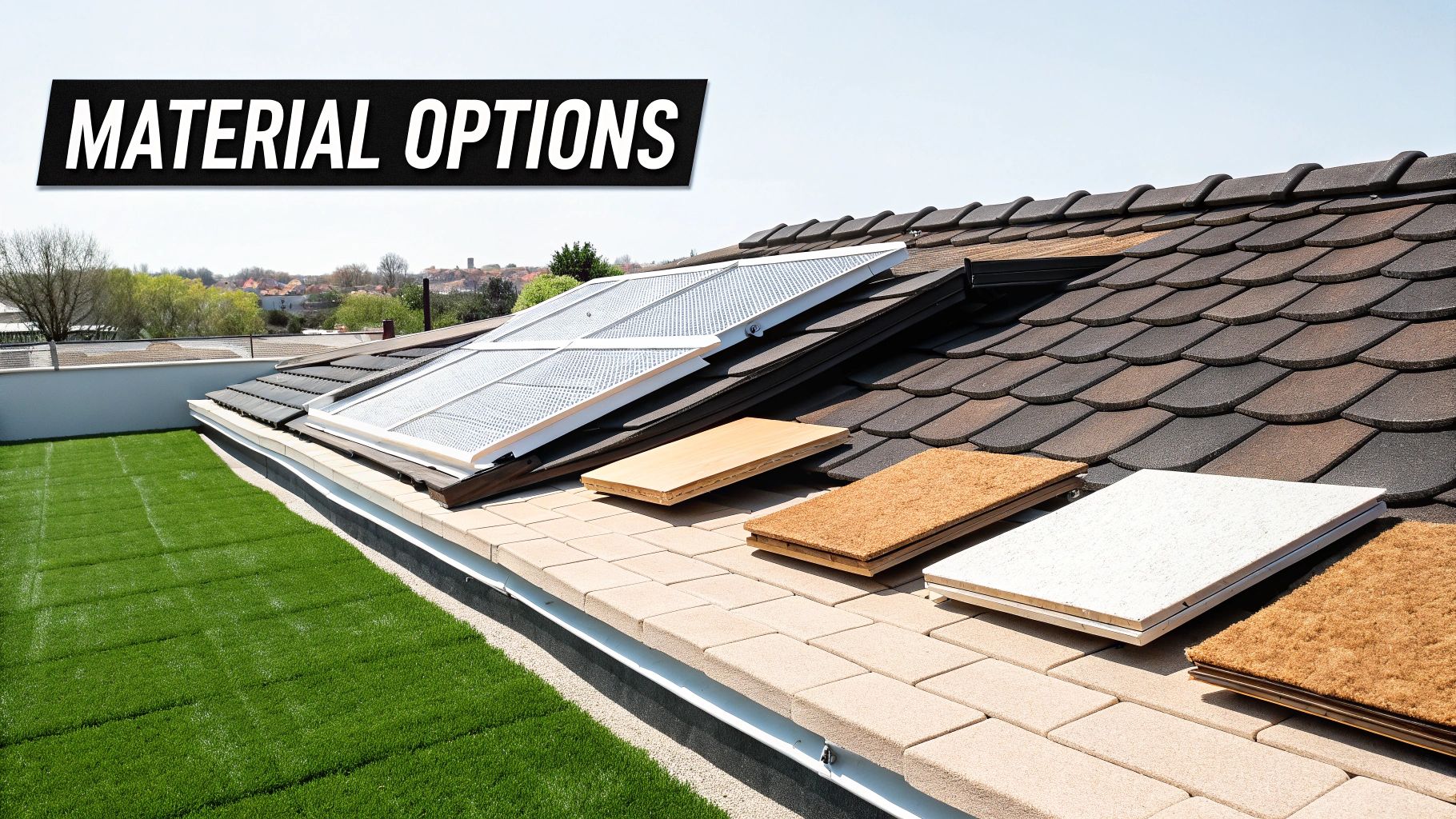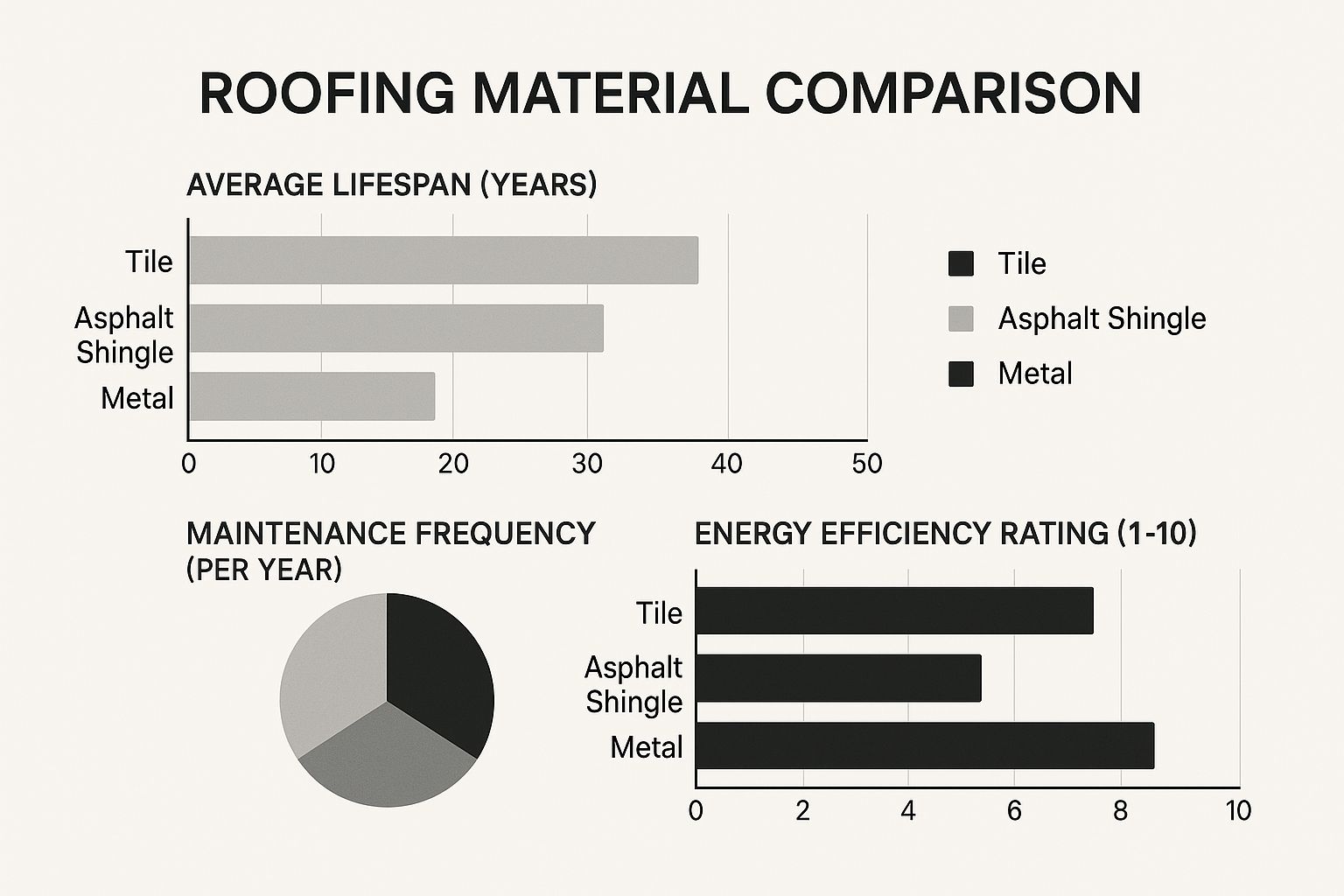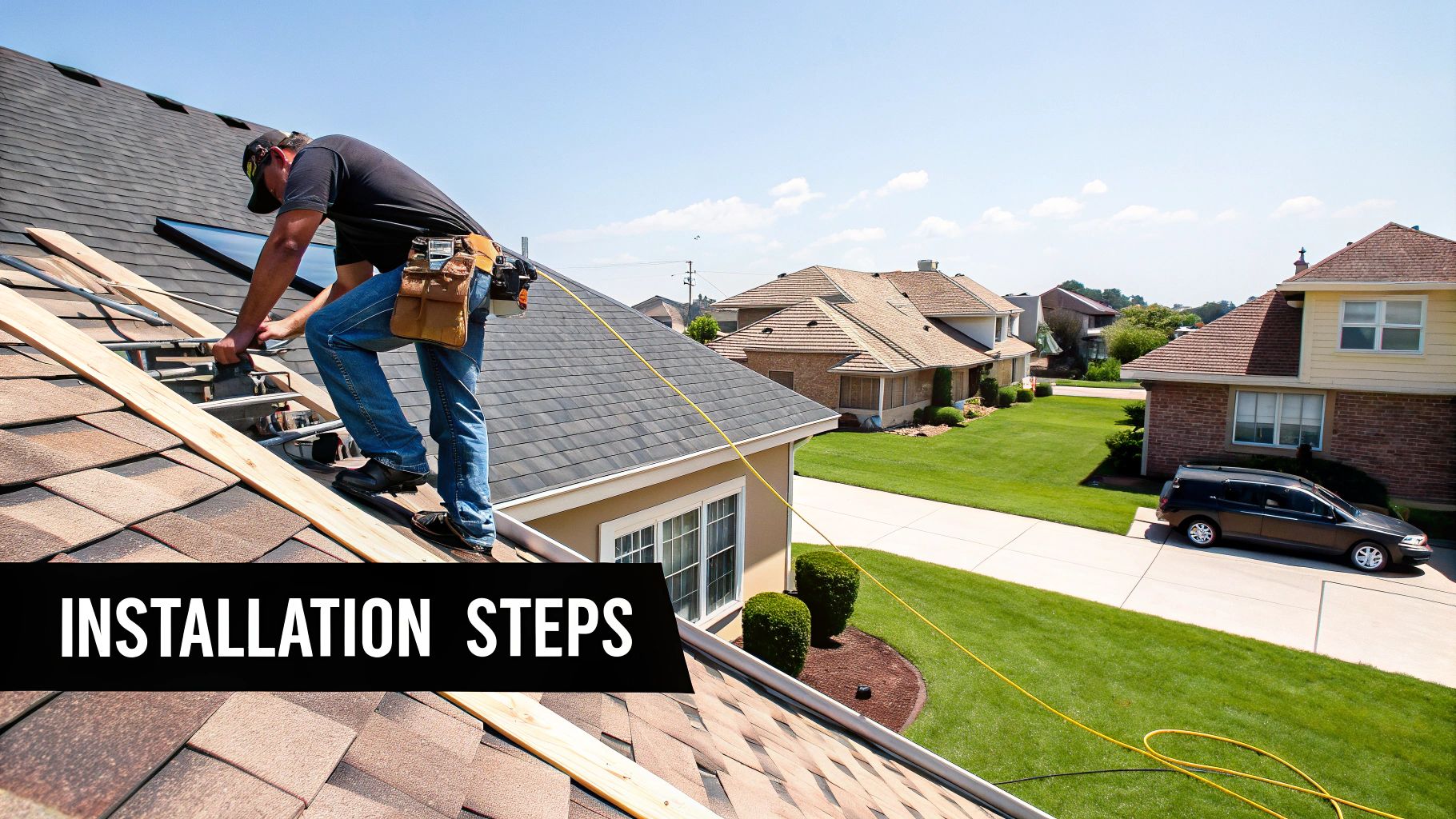When selecting the best roofing materials in Miami, FL, your decision-making process must prioritize two critical factors: hurricane resistance and energy efficiency. In our region, high-performance options like metal, tile, and specialized flat roofing systems (TPO) consistently outperform standard asphalt shingles. This is a direct result of Miami's intense sun, year-round humidity, and the threat of high-velocity winds.
To choose the right roof, you need an actionable plan. This guide will help you weigh long-term performance against your budget and architectural style to make a confident, strategic investment in your property.
How to Choose Your Ideal Miami Roofing Material

Installing a new roof on your Miami home is not a simple home improvement project; it is a critical investment in your property's resilience and safety. South Florida's climate is uniquely punishing, quickly destroying roofing options that are perfectly adequate in other parts of the country.
You are facing a combination of relentless UV radiation, constant high humidity, and the direct threat of hurricanes. This environment demands materials that don't just look good, but perform under extreme stress. This guide provides an actionable framework to help you make an informed decision for your home or business. If you're interested in making other smart choices online, you can also check out this great SEO guide.
Your 4-Point Decision Checklist for Miami Roofs
To make the right choice, you must answer these four questions. Your answers will directly determine your roof's performance, cost, and longevity in our subtropical climate.
- Extreme Weather Durability: How will it perform against 150+ mph winds, driving rain, and impacts from flying debris? Request the product's Miami-Dade Notice of Acceptance (NOA) to verify its tested capabilities.
- Long-Term Value (Lifecycle Cost): What is the total cost of ownership? Calculate this by combining the initial installation price, projected maintenance costs, and its warrantied lifespan. A cheaper roof that needs replacing in 20 years is often more expensive than a lifetime roof.
- Energy Efficiency: How will it lower your FPL bill? Look for the material's Solar Reflectance Index (SRI). A higher SRI means the roof reflects more solar heat, keeping your home cooler and reducing HVAC strain.
- Architectural & Code Compliance: Does the material complement your home's style and meet all local building codes and HOA regulations? Get written approval from your HOA before signing a contract.
The Florida roofing supply and services industry is projected to become a $5.3 billion market by 2025. This growth is driven by the urgent need for robust, weather-ready roofing solutions designed specifically for our climate. For more data on these trends, visit ibisworld.com.
Comparing Miami's Top Roofing Contenders
To simplify your decision, here is a breakdown of the most effective materials for Miami homes. Each option presents a clear set of trade-offs you must weigh.
| Material | Best For | Actionable Insight |
|---|---|---|
| Tile (Clay/Concrete) | Long-term value & timeless aesthetics. | Choose if you want a 50+ year roof and your home's structure can support the weight. |
| Metal (Aluminum/Steel) | Maximum hurricane defense & energy efficiency. | The top choice for ultimate storm protection and lower cooling bills. |
| Asphalt Shingles | Upfront budget-friendliness. | A practical option if initial cost is your primary driver and you accept a 20-25 year lifespan. |
| TPO (Flat Roofs) | Commercial properties & modern flat-roof homes. | Unbeatable for waterproofing and energy efficiency on low-slope structures. |
Comparing Residential Roofing For Miami Homes
Choosing the right roofing materials for your Miami, FL, home is a major decision with lasting financial and safety implications. The material you select is your primary defense against hurricanes, a key driver of your monthly energy costs, and a major factor in your home's curb appeal and resale value. Let's compare the most common choices—tile, metal, and architectural shingles—based on what truly matters in South Florida.
This is not about finding one "best" material. It's about providing the data you need to select the optimal fit for your home, budget, and long-term goals. Here is a direct comparison based on four critical action points: hurricane wind resistance, lifespan, installation cost, and energy efficiency.
Tile Roofing: Clay And Concrete
For generations, tile roofs have defined Miami's architectural landscape, offering a blend of classic elegance and proven weather durability. Both clay and concrete tiles are extremely heavy, giving them a natural advantage against wind uplift—but only if installed correctly.
Actionable Insight: A tile roof's performance is 100% dependent on the installation quality. The system's strength lies in its underlayment and the specific fastening method used for each tile. In Miami-Dade's High-Velocity Hurricane Zone (HVHZ), installation must adhere to strict codes to ensure every tile remains secure during a hurricane. While the initial cost is higher than shingles, a properly installed tile roof can last over 50 years, making it a superior long-term investment.
Architectural Asphalt Shingles
Modern architectural asphalt shingles are a viable, budget-friendly option for Florida, representing a significant upgrade over older 3-tab shingles. They are thicker, heavier, and feature a laminated, multi-dimensional construction that provides superior wind resistance, often rated for winds up to 130 mph.
Actionable Insight: Shingles offer the most affordable path to a new roof, but this comes with clear trade-offs. Even high-end architectural shingles have a shorter lifespan of 20 to 25 years under Miami's relentless sun, as UV radiation causes them to degrade. They are also more susceptible to algae and mildew staining, requiring more frequent cleaning.
Your Action Step: When considering shingles, you must verify the specific wind-uplift rating and ensure your contractor commits in writing to follow the manufacturer's enhanced installation protocols for high-wind zones. For any shingle roof in Miami, this is a non-negotiable requirement.
Metal Roofing: Aluminum And Steel
For pure performance and the highest level of hurricane defense, metal roofing stands in a class of its own. Standing seam metal roofs, particularly those made from aluminum, achieve some of the highest wind-uplift ratings available. The interlocking panel design creates a single, unified barrier against extreme wind and water intrusion.
Actionable Insight: For coastal Miami, aluminum is the superior choice because it is inherently corrosion-resistant and will not rust from salt spray. Metal is also an energy efficiency champion. A light-colored metal roof can reflect a significant amount of solar radiation, potentially reducing your cooling costs by up to 25%. While the initial investment is typically the highest of the three options, its 50+ year lifespan and minimal maintenance requirements deliver exceptional long-term financial value.
To help you make a data-driven decision, use this table to compare these materials side-by-side.
Miami Residential Roofing Material Comparison
This table provides a clear snapshot of how tile, metal, and architectural shingles stack up on the metrics that matter most for Miami homeowners.
| Material | Hurricane Resistance | Estimated Lifespan (Miami) | Installed Cost / Sq. Ft. | Energy Efficiency |
|---|---|---|---|---|
| Tile (Clay/Concrete) | Excellent | 50+ Years | $$$ (High) | Good to Excellent |
| Metal (Aluminum) | Superior | 50+ Years | $$$$ (Very High) | Excellent |
| Asphalt Shingles | Good | 20-25 Years | $$ (Moderate) | Fair to Good |
This data clarifies the choice: balance your immediate budget against your long-term goals for durability, maintenance, and energy savings. While asphalt shingles offer an accessible price point, both tile and metal provide significantly greater longevity and energy savings, justifying their higher upfront cost for those seeking a lifetime roofing solution.

Analyzing Commercial Roofing For Miami Businesses

Commercial buildings in Miami operate under different rules. Their large, flat, or low-sloped roofs present unique challenges, primarily managing massive amounts of water during downpours and enduring constant solar exposure. For these properties, the discussion about roofing materials in Miami, FL shifts from residential options to specialized flat roofing systems.
Here is an analysis of the top commercial contenders: TPO (Thermoplastic Olefin), PVC (Polyvinyl Chloride), and Modified Bitumen. The focus is on practical factors impacting your business's bottom line: seam strength, chemical resistance, lifecycle cost, and energy efficiency.
TPO: The Energy-Efficient Standard
TPO roofing has become the standard for many commercial properties, particularly large-footprint facilities like warehouses and retail centers where energy efficiency is a primary cost-control measure. TPO is a single-ply membrane, typically bright white, making it an excellent "cool roof."
Actionable Insight: By reflecting solar heat instead of absorbing it, a TPO roof significantly reduces a building's cooling load, leading to direct and measurable savings on your FPL bill. Its seams are heat-welded to form a monolithic, waterproof membrane across the entire roof surface. This seamless bond is exceptionally resistant to leaks—a critical feature for hurricane preparedness.
PVC: The Resilient Defender
PVC, another single-ply membrane, is often considered a premium option, offering superior resistance to chemicals and grease. Like TPO, it is available in reflective white for excellent energy savings, but its robust chemical composition makes it the mandatory choice for specific business types.
Actionable Insight: Specify PVC roofing for these scenarios:
- Restaurants: To resist degradation from grease and oils exhausted by kitchen vents.
- Manufacturing Facilities: To withstand exposure to industrial chemicals that would compromise other materials.
While PVC typically has a higher upfront cost than TPO, its superior durability in harsh environments and high puncture resistance make it a smart long-term investment, especially for roofs with heavy HVAC equipment requiring frequent foot traffic from maintenance crews.
Your Action Step: For any commercial property in Miami-Dade, you must ensure your chosen material has a Miami-Dade Notice of Acceptance (NOA). This certification proves the product has passed the enhanced testing required for use in our High-Velocity Hurricane Zone (HVHZ).
Modified Bitumen: The Time-Tested Workhorse
Modified Bitumen is the modern, high-performance evolution of traditional asphalt roofing. Its key advantage is its multi-ply construction. These redundant layers provide exceptional durability against punctures and heavy foot traffic.
Actionable Insight: Choose a Modified Bitumen system for roofs that must support heavy equipment or will have constant maintenance traffic. While older "mod-bit" systems were black and absorbed heat, modern versions are manufactured with reflective "cool roof" granules. This allows them to deliver competitive energy efficiency while retaining their signature toughness. The installation is more labor-intensive, but its proven resilience provides peace of mind for building owners who prioritize durability above all else.
Ultimately, selecting the right commercial roofing materials in Miami, FL, requires you to assess your building's daily operations, your budget, and your long-term performance expectations.
Understanding Your Miami Roof Replacement Costs
Calculating the cost of a new roof in Miami involves more than the price of materials. The final invoice is a combination of several key factors. Understanding these components is the first step toward setting a realistic budget and recognizing the long-term value of your investment.
The total cost encompasses not just the visible shingles or tiles, but also the skilled labor required for a code-compliant installation, which is often higher in South Florida due to certification requirements. It also includes mandatory permitting fees from Miami-Dade County, which ensure your project meets stringent local safety codes.
Breaking Down The Core Cost Factors
A roofing contractor's quote is a detailed calculation based on several variables, from your roof's size and complexity to your final material choice.
Here are the key cost drivers to look for in your estimate:
- Material Prices: The cost per square foot for your chosen material (tile, metal, shingles) is the largest variable.
- Skilled Labor Rates: Installation that meets Miami-Dade's High-Velocity Hurricane Zone (HVHZ) standards requires specialized, certified crews.
- Permitting Fees: These administrative costs are a non-negotiable part of ensuring your project is legal and code-compliant.
- Structural Work: If your existing roof deck has rot or damage, or if it needs reinforcement to support a heavier material like tile, these necessary repairs will add to the total cost.
A quality roof is one of the most important investments you can make to protect your family and the structure of your home.

Actionable Insight: Remember, you are not just buying materials; you are investing in a complete roofing system. This includes the underlayment, fasteners, and flashing. Every component must be installed to perfection to withstand hurricane-force winds and prevent water intrusion.
How Economic Trends Impact Your Bottom Line
It is impossible to discuss current roofing costs without acknowledging recent economic trends. Global supply chain disruptions and inflationary pressures have caused significant price volatility for roofing materials in Miami, FL.
From 2019 to 2025, material prices surged due to these pressures. For example, the cost for a single square of architectural shingles rose from approximately $100 to over $150, a 50% increase. Essential components like roofing nails doubled in price, from $20 to $40 per box. This was driven by a combination of logistical challenges and increased shipping costs.
This economic reality underscores the importance of choosing a durable, long-lasting roofing system. While the higher upfront cost of a metal or tile roof may seem daunting, its superior longevity provides better long-term financial value compared to a cheaper option that will require replacement sooner at future inflated prices.
Making The Smartest Roofing Choice For Your Property

When selecting roofing materials in Miami, FL, there is no single "best" answer. The right choice is a strategic decision that aligns a material’s strengths with your property's specific needs, your budget, and your risk tolerance. The performance data points to clear winners for different priorities.
To make your decision process more direct, we have outlined common scenarios faced by Miami property owners. Each recommendation is based on real-world performance to show you exactly why it's the right course of action.
Recommendations For Specific Scenarios
Identify which of these situations best describes your needs to guide you toward the optimal decision.
-
For the homeowner demanding maximum hurricane defense and longevity: Your best choice is a standing seam aluminum metal roof. Its interlocking panel design provides superior wind uplift resistance, and its natural corrosion resistance is essential for our coastal environment. With a 50+ year lifespan, it is a "one and done" investment.
-
For the business owner focused on reducing energy costs: A white TPO roof is the clear winner. Its high solar reflectivity is a game-changer for large, flat commercial roofs, directly reducing cooling expenses and minimizing wear on HVAC systems.
-
For the budget-conscious homeowner needing reliable warranty protection: Modern architectural asphalt shingles offer a strong balance. They provide wind ratings up to 130 mph and are backed by robust manufacturer warranties, all while keeping the initial investment significantly lower than metal or tile.
Actionable Insight: Your home's architectural style is a critical factor. A classic Spanish-style villa in Coral Gables requires a tile roof to maintain its character, while a modern home is an ideal candidate for a standing seam metal system. The material must enhance your home's design, not detract from it.
The Non-Negotiable Factor: Miami-Dade Building Codes
Regardless of your material preference, your final decision is governed by Miami-Dade's High-Velocity Hurricane Zone (HVHZ) building codes. These are not suggestions; they are mandatory regulations dictating the precise installation methods required to ensure a roof can withstand a major hurricane. This is a legal requirement for your safety.
Furthermore, a new roof significantly impacts your property's value. As you evaluate the return on this investment, it is helpful to understand key real estate investment metrics.
Finally, be aware that global trade policies can affect the cost of roofing materials in Miami, FL. For example, in 2025, tariffs on components like MDI and fire retardants created cost pressures across the local market. Understanding how global factors impact Florida's roofing prices can help you plan your project.
Frequently Asked Questions About Miami Roofing
When choosing a roof in Miami, FL, property owners have critical questions that demand clear, practical answers. This section addresses the most common inquiries to help you make a confident decision.
What Is The Most Hurricane-Proof Roofing Material In Miami?
The strongest roof is not a single material, but a complete system. While a standing seam metal roof, installed to specification, generally provides the highest wind uplift ratings, a properly fastened tile roof is also exceptionally resilient against hurricane-force winds.
Actionable Insight: The key to a hurricane-proof roof is not the specific material, but strict adherence to the installation standards of Miami-Dade's High-Velocity Hurricane Zone (HVHZ) building codes. These codes dictate the underlayment, sheathing, and exact fastening patterns required. The quality of the installation is what ultimately determines a roof's ability to survive a major storm.
A roof's hurricane resistance is only as strong as its weakest link. A top-tier material installed incorrectly will fail long before a standard material installed perfectly to code. Always prioritize a certified, experienced roofer who understands HVHZ requirements.
How Much Do Cool Roofs Actually Save On Energy Bills?
"Cool roofs" provide real, quantifiable savings in Miami's climate. They use highly reflective materials (like white TPO, light-colored metal, or specialized "cool" tiles) to reflect sunlight and quickly release absorbed heat.
Actionable Insight: This process significantly reduces the amount of heat transferred into your home or building. As a result, your air conditioner runs less, leading to noticeable reductions in your monthly energy bills. Over the long cooling season in Miami, the investment in cool roofing materials often pays for itself through these savings. You can see how great these roofs look by checking out this image of a Miami home with a beautifully finished project.
Does My Roof Always Need A Full Replacement After A Hurricane?
Not necessarily. The need for a full replacement depends on the type and extent of the damage. A professional inspection is the only way to determine the correct course of action.
- When to Repair: Minor issues like a few missing shingles, a small number of cracked tiles, or localized flashing damage can often be professionally repaired to restore the roof's integrity.
- When to Replace: Widespread material loss (e.g., large sections of missing shingles or shattered tiles) indicates the system is compromised and needs replacement. Crucially, any damage to the underlying roof deck or sheathing almost always necessitates a full replacement to ensure the building's structural safety.
Actionable Insight: After any major storm, your first step should be to call a licensed and insured Miami roofer for an official damage assessment. They will provide the necessary documentation for your insurance claim and a clear, actionable plan to secure your property.
Navigating a roof replacement can be complex, but you don't have to do it alone. For a professional inspection and a clear, honest quote tailored to your property's specific needs, trust the experts at Exact Roofing. Get your free estimate today and ensure your home is protected by a high-quality roof built to withstand the Miami climate.

